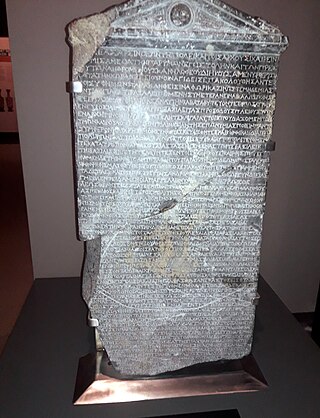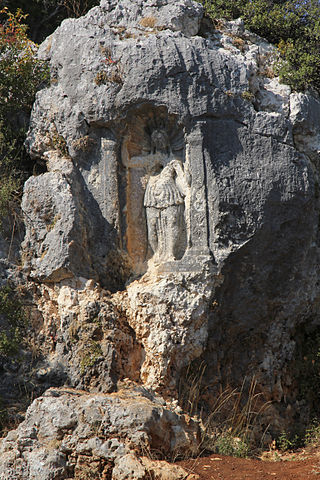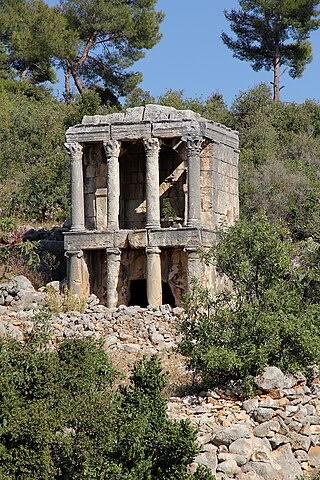
The Warrior relief of Efrenk is a rock relief from the Greco-Roman period, probably the 2nd century AD, located by the Lamos river (modern day Limonlu) in Cilicia, southern Turkey.

The Warrior relief of Efrenk is a rock relief from the Greco-Roman period, probably the 2nd century AD, located by the Lamos river (modern day Limonlu) in Cilicia, southern Turkey.

The relief is about two kilometres north of Sömek in the Silifke district of Mersin Province, about 30 km northeast of the city of Silifke and 20 km north of Kızkalesi, the ancient Korykos. It is carved into a northwest-facing cliff-face beside a steep path leading down to the Lamos. A ford at this spot connected the ancient settlement of Efrenk on the hill south of the relief with Veyselli on the other side of the Lamos. The route continued on to the settlement at the mouth of the Lamos, Antiochia Lamotis (now Limonlu). After passing the relief, the route led south past Sömek towards Canbazlı and Olba, as well as Korykos and Elaiussa Sebaste on the Mediterranean coast. The river Lamos is often treated as the border between the ancient regions of Rough Cilicia (Kilikia Tracheia) in the west and Flat Cilicia (Kilikia Pedias) in the east.
The Athena relief of Sömek is roughly 600 m to the southeast.

The relief is carved into a vertical cliff-face about 5 m above street level. It is 1.9 m high and depicts a warrior, surrounded by a naiskos. The legs are badly damaged; the right leg supports his weight, while the left leg hangs free. His raised right arm holds up a spear. On his left side he wears a sword, with his left hand on the grip. He is dressed in a short, belted chiton, with clearly carved drapery. There are traces of white paint on the relief in several spaces - between the head and the right arm, for instance, there are traces of red paint. Paint very rarely survives on Cilician cliff reliefs.
On the left pilaster there is an inscription at about chest height, which has been resolved as an 8 line inscription:
῾Ός δ’ ἂν βά- |
Josef Keil and Adolf Wilhelm report the illegible traces of an "actual funerary inscription in the background on the left and right sides of the figure's head." The letter forms date the inscription to the middle of the Imperial period, while similarities in posture and clothing led Serra Durugönül to date the relief to the second century AD when she studied the Cilician cliff reliefs in the 1980s.
The first short description (with an incomplete reading of the inscription) was published by Edward L. Hicks in 1891 in his Inscriptions from Western Cilicia. The ancient historians Keil and Wilhelm travelled Cilicia in 1891 and 1925, publishing an account in 1931, Denkmäler aus dem Rauhen Kilikien (Monuments of Rough Cilicia), in which the relief of Efrenk is described with a fuller reading of the inscription. In 1989 Serra Durugönül completed a dissertation, Die Felsreliefs im Rauhen Kilikien (The Cliff-reliefs of Rough Cilicia), which also discusses the warrior relief.

Cilicia was a geographical region in southern Anatolia, extending inland from the northeastern coasts of the Mediterranean Sea. Cilicia has a population ranging over six million, concentrated mostly at the Cilicia plain. The region includes the provinces of Mersin, Adana, Osmaniye and Hatay.

Philip I Epiphanes Philadelphus was a Hellenistic Seleucid monarch who reigned as the king of Syria from 94 to either 83 or 75 BC. The son of Antiochus VIII and his wife Tryphaena, he spent his early life in a period of civil war between his father and his uncle Antiochus IX. The conflict ended with the assassination of Antiochus VIII; Antiochus IX took power in the Syrian capital Antioch, but soon fell in battle with Antiochus VIII's eldest son Seleucus VI.

Seleucus VI Epiphanes Nicator was a Hellenistic Seleucid monarch who ruled Syria between 96 and 94 BC. He was the son of Antiochus VIII and his Ptolemaic Egyptian wife Tryphaena. Seleucus VI lived during a period of civil war between his father and his uncle Antiochus IX, which ended in 96 BC when Antiochus VIII was assassinated. Antiochus IX then occupied the capital Antioch while Seleucus VI established his power-base in western Cilicia and himself prepared for war. In 95 BC, Antiochus IX marched against his nephew, but lost the battle and was killed. Seleucus VI became the master of the capital but had to share Syria with his brother Demetrius III, based in Damascus, and his cousin, Antiochus IX's son Antiochus X.

Philip II Philoromaeus or Barypous, a ruler of the Hellenistic Seleucid Empire, was the son of the Seleucid king Philip I Philadelphus, and the last Seleucid king.

Geghard is a medieval monastery in the Kotayk province of Armenia, being partially carved out of the adjacent mountain, surrounded by cliffs. It is listed as a UNESCO World Heritage Site with enhanced protection status.

The Armenian Kingdom of Cilicia, also known as Cilician Armenia, Lesser Armenia, Little Armenia or New Armenia, and formerly known as the Armenian Principality of Cilicia, was an Armenian state formed during the High Middle Ages by Armenian refugees fleeing the Seljuk invasion of Armenia. Located outside the Armenian Highlands and distinct from the Kingdom of Armenia of antiquity, it was centered in the Cilicia region northwest of the Gulf of Alexandretta.

Mersin Province, formerly İçel Province, is a province and metropolitan municipality in southern Turkey, on the Mediterranean coast between Antalya and Adana. Its area is 16,010 km2, and its population is 1,916,432 (2022). The provincial capital and the biggest city in the province is Mersin, which is composed of four municipalities and district governorates: Akdeniz, Mezitli, Toroslar and Yenişehir. Next largest is Tarsus, the birthplace of Paul the Apostle. The province is considered to be a part of the geographical, economical and cultural region of Çukurova, which covers the provinces of Mersin, Adana, Osmaniye and Hatay.

The Limonlu River, also known as Gökler Deresi, is a river of ancient Cilicia, now in Mersin Province, Turkey.

Cilician pirates dominated the Mediterranean Sea from the 2nd century BC until their suppression by Pompey in 67–66 BC. Because there were notorious pirate strongholds in Cilicia, on the southern coast of Asia Minor, the term "Cilician" was long used to generically refer to any pirates in the Mediterranean.

Yılankale is a late 12th–13th century Armenian castle in Adana Province of Turkey. It is known in Armenian as Levonkla after its possible founder—King Leo (Levon) I the Magnificent of the Armenian Kingdom of Cilicia. Medieval Armenian names attached to the site are Kovara and Vaner.

Adana Archaeology Museum is a museum in Adana that houses the historical heritage of Cilicia in a converted textile factory. It is one of the oldest archaeological museums in Turkey.

Nagidos was an ancient city of Cilicia. In ancient times it was located between Anemurion to the west and Arsinoe to the east. Today its ruins are found on the hill named Paşabeleni at the mouth of the Sini Cay near Bozyazı in Mersin Province, Turkey. It lies at a distance of ca. 20 km to the east of Anamur. Like its eastern neighbor Kelenderis, it was a colony of Samos. The small island of Nagidoussa is opposite Nagidos; on it are the ruins of an Ottoman fortress.

The Athena relief of Sömek is a Greco-Roman rock relief, located some two kilometres north of the village of Sömek in Silifke district of Mersin province in Turkey, near the valley of the Limonlu river, the ancient Lamos. In antiquity, the river formed the border between "Rugged Cilicia" in the west and "Flat Cilicia" in the east.

The Hemite relief is a Hittite rock relief at Gökçedam in the central district of Osmaniye Province in Turkey, about 20 km northwest of the provincial capital of Osmaniye. Rock reliefs are a prominent aspect of Hittite art.

A rock relief or rock-cut relief is a relief sculpture carved on solid or "living rock" such as a cliff, rather than a detached piece of stone. They are a category of rock art, and sometimes found as part of, or in conjunction with, rock-cut architecture. However, they tend to be omitted in most works on rock art, which concentrate on engravings and paintings by prehistoric peoples. A few such works exploit the natural contours of the rock and use them to define an image, but they do not amount to man-made reliefs. Rock reliefs have been made in many cultures throughout human history, and were especially important in the art of the ancient Near East. Rock reliefs are generally fairly large, as they need to be in order to have an impact in the open air. Most of those discussed here have figures that are over life-size, and in many the figures are multiples of life-size.

The Tower of Gömeç is a Roman watch tower in Cilicia, present-day Mersin Province in southern Turkey.

Imbriogon was an ancient place in Cilicia Trachea, whose modern name is Demircili in Silifke district, in Mersin province, Turkey. It lay on the road from Seleukia in the Kalykadnos to Diocaesarea (Uzuncaburç), about 8 kilometres north of Seleukia.

Tarḫunz was the weather god and chief god of the Luwians, a people of Bronze Age and early Iron Age Anatolia. He is closely associated with the Hittite god Tarḫunna and the Hurrian god Teshub.

The Sarıaydın inscription is an Aramaic inscription found in situ in 1892 near the village of Sarıaydın in Southern Anatolia. It is also known as the Sarıaydın Hunting inscription or the Cilician Hunting inscription. It was discovered on the Austrian expedition to Cilicia of Rudolf Heberdey and Adolf Wilhelm.

Cilicia is the Latin and English language name of a region of southern Anatolia and the northern Levant from the 2nd millennium BC. The region was part of many different cultural and political spheres in succession, including the Hittites, Ancient Greece, Roman Empire, Abbasid Caliphate, the Armenian Kingdom of Cilicia, and the Turkish Ramadanid Emirate.